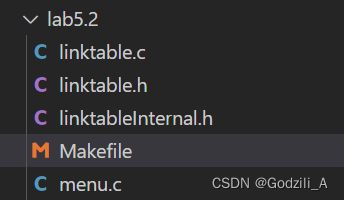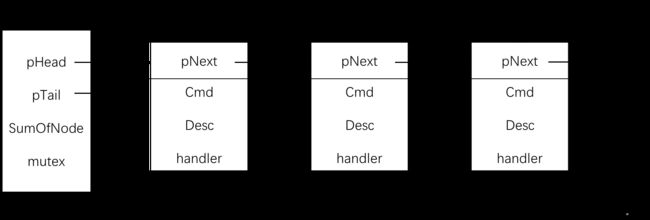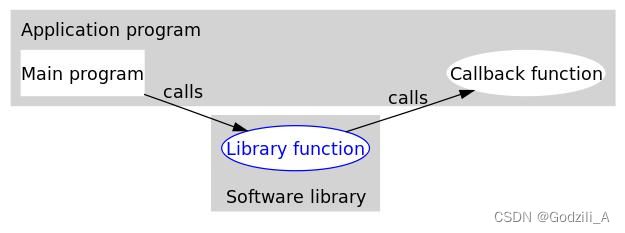高级软件工程作业3:深入理解Callback函数
-
-
-
- 一、实验目的
- 二、实验内容
-
-
- 1.lab5.2的整体结构
- 2.Callback函数的具体分析
-
- 三、实验总结
-
-
一、实验目的
参考《代码中的软件工程》第六章可复用软件设计及lab5.2的源代码,完成实验并写一篇实验报告,总结Callback函数的工作机制以及通过参数进行解耦合的方法,深入理解接口设计中的抽象分层。
二、实验内容
1.lab5.2的整体结构
先大概介绍一下lab5.2中的内容,打开lab5.2文件夹,可以看到里面有5个文件:
linktableInternal.h为链表的定义文件,定义了一个链表头结点struct LinkTable和链表的结点结构struct LinkTableNode。注意,在linktable.h文件中将两个结构体的名字重新命名为tLinkTableNode和tLinkTable。
#include linktable.h文件中声明了一些链表相关的操作函数,包括创建链表、添加链表结点、删除链表结点等,而具体的函数实现在linktable.c文件中,其中SearchLinkTableNode函数的实现就是本次实验所关注的内容。
#ifndef _LINK_TABLE_H_
#define _LINK_TABLE_H_
#include "linktableInternal.h"
#define SUCCESS 0
#define FAILURE (-1)
/*
* LinkTable Node Type
*/
typedef struct LinkTableNode tLinkTableNode;
/*
* LinkTable Type
*/
typedef struct LinkTable tLinkTable;
/*
* Create a LinkTable
*/
tLinkTable * CreateLinkTable();
/*
* Delete a LinkTable
*/
int DeleteLinkTable(tLinkTable *pLinkTable);
/*
* Add a LinkTableNode to LinkTable
*/
int AddLinkTableNode(tLinkTable *pLinkTable, tLinkTableNode * pNode);
/*
* Delete a LinkTableNode from LinkTable
*/
int DelLinkTableNode(tLinkTable *pLinkTable, tLinkTableNode * pNode);
/*
* Search a LinkTableNode from LinkTable
* int Conditon(tLinkTableNode * pNode, void * args);
*/
tLinkTableNode * SearchLinkTableNode(tLinkTable *pLinkTable, int Conditon(tLinkTableNode * pNode, void * args), void * args);
/*
* get LinkTableHead
*/
tLinkTableNode * GetLinkTableHead(tLinkTable *pLinkTable);
/*
* get next LinkTableNode
*/
tLinkTableNode * GetNextLinkTableNode(tLinkTable *pLinkTable, tLinkTableNode * pNode);
#endif /* _LINK_TABLE_H_ */
menu.c文件首先定义了一个菜单命令数据结构,表中的数据为菜单项目的命令、命令描述和具体的操作函数,另外还有一个tLinkTableNode类型的指针,用于连接各个数据结点,在这一设计中,tLinkTableNode只需要关心它是否连接了其他东西,而不需要关心其中的具体内容。换句话说,我们可以定义很多个不同类型的结构体用于存储不同类型的数据,只要里面有一个指针类型的结构体成员,就可以调用linktable.c中定义的函数来为自己提供服务。然后menu.c定义了一些具体的命令实现,方便用户调用。函数的主体部分就是不断接收用户输入的命令,然后根据这个命令是否存在而做出进一步的操作。
#include makefile文件定义了一些命令,方便用户运行项目。
CC_PTHREAD_FLAGS = -lpthread
CC_FLAGS = -c
CC_OUTPUT_FLAGS = -o
CC = gcc
RM = rm
RM_FLAGS = -f
TARGET = menu
OBJS = linktable.o menu.o
all: $(OBJS)
$(CC) $(CC_OUTPUT_FLAGS) $(TARGET) $(OBJS)
.c.o:
$(CC) $(CC_FLAGS) $<
clean:
$(RM) $(RM_FLAGS) $(OBJS) $(TARGET) *.bak
2.Callback函数的具体分析
回过头来,继续分析本实验的关键部分,Callback函数是怎么实现的?这里先给出Callback函数的一个定义:
A “callback” is any function that is called by another function which takes the first function as a parameter。 也就是说,函数 F1 调用函数 F2 的时候,函数 F1 通过参数给 函数 F2 传递了另外一个函数 F3 的指针,在函数 F2 执行的过程中,函数F2 调用了函数 F3,这个动作就叫做回调(Callback),而先被当做指针传入、后面又被回调的函数 F3 就是回调函数。
在本实验中,Main program对应FindCmd函数,Library function对应SearchLinkTableNode函数,Callback function对应SearchCondition函数。
在回调函数中,关键的部分就是函数SearchCondition被当作参数传递给了另一个函数SearchLinkTableNode
// Main program
tDataNode* FindCmd(tLinkTable * head, char * cmd)
{
return (tDataNode*)SearchLinkTableNode(head, SearchCondition, (void*)cmd);
}
在SearchLinkTableNode中会调用SearchCondition来检查是否满足要求,从而执行接下来的命令。
// Library function
tLinkTableNode * SearchLinkTableNode(tLinkTable *pLinkTable,
int Condition(tLinkTableNode * pNode, void * args),
void * args)
{
if(pLinkTable == NULL || Condition == NULL)
{
return NULL;
}
tLinkTableNode * pNode = pLinkTable->pHead;
while(pNode != NULL)
{
if(Condition(pNode, args) == SUCCESS)
{
return pNode;
}
pNode = pNode->pNext;
}
return NULL;
}
实际上SearchLinkTableNode函数并不在意SearchCondition函数是怎么实现的,它只需要SearchCondition函数有两个指定类型的输入参数和一个int型的返回值就可以了,也就是说,我们可以改变在不违背这个原则的基础上随意传入其他的函数指针,从而在不改变SearchLinkTableNode的同时实现不同的功能,这就是软件设计中的解耦思想。
// Callback function
int SearchCondition(tLinkTableNode * pLinkTableNode, void * args)
{
char * cmd = (char*) args;
tDataNode * pNode = (tDataNode *)pLinkTableNode;
if(strcmp(pNode->cmd, cmd) == 0)
{
return SUCCESS;
}
return FAILURE;
}
三、实验总结
在本实验中,利用callback函数参数使Linktable的查询接口更加通用,有效地提高了接口的通用性。另外,本次实验代码在多处使用了强制类型转换的操作,隐藏了接口内部的细节,使得接口更加通用(如InitMenuData和SearConditon函数等)。
参考资料:
C 语言回调函数详解
作者:518


